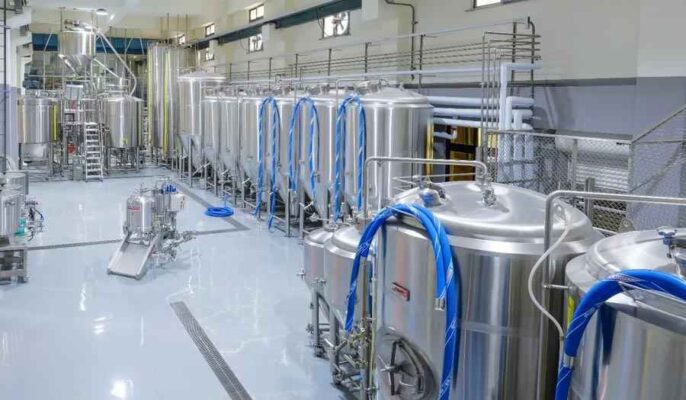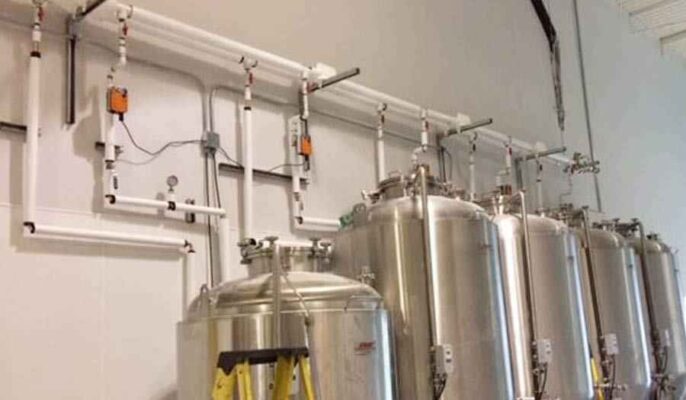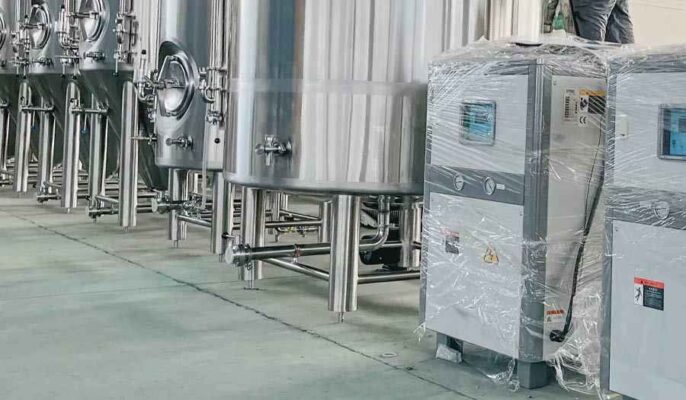Homebrewing beer has experienced a surge in popularity in recent years. While beginner homebrewers often start with basic equipment kits, more advanced brewers look to customize their systems to match their specific needs and brewing goals.
Customizing a brewhouse setup allows meticulous control over each phase of the beer production process. Carefully chosen vessels, valves, sensors and control systems enable brewers to fine-tune recipes and achieve consistency between batches. Commercial microbreweries also benefit from tailored equipment that streamlines operations at their production scale.
This guide will explore the key considerations and components involved in designing and building customized professional-grade brewing equipment.
Overview of customized beer brewing equipment
A brewhouse setup includes the equipment used for mashing, lautering, boiling, fermenting, conditioning, filtering and packaging beer. While off-the-shelf systems are available, many serious brewers opt to customize their equipment.
Benefits of customized systems:
- Fine-tuned for specific production goals and batch sizes
- Optimized material choices, dimensions and configurations
- Flexibility to accommodate special processes and ingredients
- Advanced automation and process control capabilities
- Efficient workflows and space utilization
- Cost savings versus pre-made turnkey systems
- Unique aesthetics and branding
Customization does require significant planning, expertise and upfront costs. Key factors when designing a customized brewhouse include:
Brewing Volume and Floor Space
The batch size and annual production volume will determine the capacity requirements for vessels, storage tanks and packaging lines. The physical footprint should allow efficient workflows.
Power and Utilities
Electrical, water, steam and wastewater needs must be estimated for all equipment. Cooling systems may also be required.
Material Selection
Vessels and pipes must be constructed from food-grade and corrosion-resistant materials able to withstand high temperatures and pressure. Stainless steel is commonly used.
Automation Level
Consider the degree of manual versus automated control over material handling, temperature, valves, pumps and sensors.
Budget
Equipment costs, shipping, installation and customization services must align with budget constraints.
Aesthetics
Match brewhouse aesthetics and finishes to brand image and facility decor.
Careful planning and expert advice ensures a customized brewhouse that maximizes quality, efficiency and value over the long term.

Customized Brewhouse Equipment Guide
The main components and options for customizing a brewhouse setup are outlined below:
Mashing and Lautering
| Equipment | Key Features |
|---|---|
| Mash tun | Custom size and shape, single vs dual vessel design, material (stainless, copper), insulation, automated temperature control, automated rakes |
| Lauter tun | Custom dimensions, false bottom design, sparge arms, wort grant design, level sensors, automated valve control |
| Mash filter | Filter plate size and material, fully automated operation, front-to-back vs upflow configuration |
| Pumps | Custom flow rates, self-priming vs standard, impeller material, worm gear for high viscosity |
| Piping | Diameter, valves, sensors and insulation tailored to process |
Wort Boiling and Cooling
| Equipment | Key Features |
|---|---|
| Brew kettle | Custom dimensions, direct vs indirect heat, automation of boiling, stirring and cooling steps |
| Heat exchanger | Type (plate, shell and tube), materials (stainless, copper), multiple units for multi-stage cooling |
| Cooling jacket | Custom jacket design for brew kettle walls, glycol chilling system |
| Steam boiler | Output matched to vessel sizes and boil rates, fuel type (gas, wood, electric) |
| Flue gas condenser | Heat recovery for pre-heating water, fully automated |
Fermentation and Conditioning
| Equipment | Key Features |
|---|---|
| Fermentation tanks | Custom size, shape, number based on batch size and annual production, cooling jackets, temperature control, stainless vs oak |
| Brite tanks | Custom size and number, glycol chilling jackets, pressure capability if carbonating, level sensors |
| Yeast propagation | Custom stainless tanks, fermenter turned propagator, temperature control, yeast handling system |
| Racking and transfers | Custom sanitary pipe diameters, automated valves and pumps, flow meters |
Filtration and Packaging
| Equipment | Key Features |
|---|---|
| Filters | Custom micron ratings, plates and housing material, fully automated operation |
| Carbonation | Inline or pre-tank, stone/diffuser vs surface diffusion |
| Bottling/canning lines | Custom throughput, bottle/can sizes, fill levels, labeling, 4/6/12 pack configurations |
| Kegging | Washer, filler and sealer matched to keg sizes and volumes |
| Bundlers and palletizers | Automated systems sized for packaging line and warehouse logistics |
Monitoring and Control Systems
| Subsystem | Options |
|---|---|
| Sensors | Customized temperature, pressure, flow and level sensors |
| PLC units | Automated recipe control, batch tracking, CIP routines |
| HMI interfaces | User-friendly brewhouse control screens and settings |
| Data logging | Custom data storage and analytics reporting |
| Alerts and notifications | Text or app-based alerts for out-of-spec conditions |
Utilities and Infrastructure
| Utility | Customization |
|---|---|
| Hot liquor tank | Sized to support mash and sparge water needs |
| Glycol system | Sized for fermenter and brite tank cooling loads |
| CO2 system | Match tank size, pressure and purity for carbonation method |
| Steam system | Boiler, piping, valves, and insulation sized for vessels |
| Grain handling | Conveyors, mills, storage bins and silos designed for recipe needs |
| Clean-in-place | Automated CIP balls, spray balls, pumps and chemical dosing |
| Wastewater | Sloped floors, collection system, pumps and treatment sized for volumes |
| Electrical | Panel, cables and outlets rated for all equipment loads |
Careful selection of each brewhouse component based on brewing goals enables maximum quality and consistency between batches.
Applications of customized beer brewing equipment
Customized brewing equipment enables excellent control over processes for:
- Craft breweries – Unique recipes, seasonal offerings, specialty ingredients
- **Production breweries **- Consistent flagship and year-round beers at scale
- Taproom microbreweries – Small batches for on-premise consumption
- Alternate fermentables – Wine, cider, mead, kombucha, tea-based brews
- Research and development – Pilot batches, experimental techniques
- Beverage programs – Breweries at restaurants, hotels, campus dining halls
- Contract brewing – Equipment rented out for use by various clients
With the right expertise, customized equipment can be designed to handle the specific needs of any brewing operation.
Custom Brewhouse Design Specifications
Key parameters and standards to consider when engineering a customized brewhouse setup:
Vessels and Tanks
- Volume – match batch and production size
- Height to diameter ratio – optimize for workflow
- Material – stainless steel grade and finish
- Wall thickness – structural integrity
- Insulation – reduce heat loss
- Sight glasses – shape, size, location
- Smooth interior – reduce accumulation
- Slope – facilitate drainage
- Valves – types, sizes, placement
- Tri-clover connections – international standard
- Level sensors – types, redundancy
Piping and Pumps
- Pipe types – stainless, PVC, food-grade plastic
- Pipe diameter – optimize flow
- Valves – manual, actuated, sanitary
- Sensors – pressure, temperature, flowmeters
- Pipe slopes – facilitate drainage
- Pump types – centrifugal, positive displacement
- Pump controls – VFD, pressure regulating
Controls and Automation
- PLC models – features, I/O, redundancy
- SCADA software – optimize interface
- Actuators – pneumatic, electric
- Sensors – accuracy, precision, redundancy
- Motors – efficiency, access, wiring
-Operator interface – intuitive controls - Reporting – data logging, batch records
- Communication bus – fieldbus, ethernet
Electrical and Utilities
- Power – voltage, phases, amps per circuit
- Panel – size, materials, redundancy
- Wiring – gauge size, separation, color coding
- Lighting – fixtures, switches, placement
- Ventilation – directional air flow, HEPA filters
- Water – inlet types, backflow prevention
- Steam – boiler type, pipes, insulation, traps
- Glycol – chiller sizing, heat exchanger selection
- CO2 – tank size, purity, distribution
Following relevant codes and standards ensures the brewhouse will perform safely, efficiently and reliably long term.

customized beer brewing equipment Suppliers and Pricing
Many equipment manufacturers specialize in fully customized brewhouse design, fabrication and installation. Typical suppliers include:
Brewhouse Suppliers
| Company | Location | Pricing |
|---|---|---|
| JV Northwest | Canby, Oregon, USA | $$ to $$$ |
| Craftwerk Brewing Systems | Calgary, Canada | $$ to $$$ |
| Premier Stainless Systems | Escondido, California, USA | $$$ |
| Malt Handling | Buffalo, New York, USA | $ to $$ |
| Rolec Prozess & Brautechnik | Panschwitz-Kuckau, Germany | $$$$ |
| Canadian Brewing Equipment | Surrey, Canada | $ to $$$ |
Pricing Legend
- $ = Under $50,000
- $$ = $50,000 to $150,000
- $$$ = $150,000 to $500,000
- $$$$ = Over $500,000
Pricing varies widely depending on degree of customization, batch size, materials and automation. Get quotes from multiple vendors once system parameters are defined.
Installation and Operation of customized beer brewing equipment
Installing and operating a customized brewhouse system requires planning and training:
- Work with equipment supplier to plan delivery, unloading, space requirements, utility connections and installation sequence.
- Obtain necessary permits and pass inspections by relevant authorities before starting operation.
- Clean and sanitize entire system thoroughly prior to first use.
- Train staff thoroughly on operating procedures for all equipment components.
- Follow manufacturer instructions for use of any automated systems and specialty equipment pieces.
- Develop detailed standard operating procedures and recipes optimized for the new equipment.
- Monitor initial batches closely to identify any tweaks needed to balance yield, quality and taste.
- Implement a preventative maintenance schedule and routine calibration of sensors and instruments.
- Document any issues during equipment warranties and work with suppliers as needed.
Taking the time to properly install and learn customized equipment results in years of optimized performance and great beer.
Maintenance of customized beer brewing equipment
To sustain optimal performance, customized brewing equipment requires ongoing maintenance:
Daily/Weekly
- Visual inspections of vessels, pipes, valves, pumps and sensors
- Check for leaks, clogs, unusual wear or corrosion
- Test operation of valves and pumps
- Confirm gauges and sensors are reading accurately
- Inspect gaskets and seals during cleaning
- Lubricate parts like pumps as needed
Monthly
- Inspect fasteners and sockets for tightness
- Confirm proper sensor, actuator and relay operation
- Test emergency stop functionality
- Check calibration of sensors and measurement devices
- Validate control sequences and settings
- Review logged data for any out of range trends
Yearly
- Thorough deep cleaning and passivation of all stainless steel
- Full calibration check and adjustment of instruments
- Update control system software and security
- Pressure test vessels, piping and connections
- Hull cleaning of steam boilers and kettles
- Check shaft alignment on pumps and motors
- Comprehensive inspection by service technician
Following prescribed maintenance schedules optimizes uptime and extends the usable life of the equipment.
Choosing a customized beer brewing equipment Supplier
Several criteria to consider when selecting a supplier of customized beer brewing equipment:
Experience
- Years of experience designing and building brewhouse systems
- Reference installations of similar size and complexity
- Proven reputation in the craft brewing industry
Offerings
- Provide complete brewhouse packages or à la carte components
- Flexibility to accommodate special requests and budgets
- Wide selection of equipment brands and options to choose from
Services
- Handle design, fabrication, delivery, installation and training
- Available for ongoing technical support after installation
- Offer extended warranty and maintenance contracts
Quality
- Use high-grade stainless steel and components
- Robust quality control procedures
- International manufacturing standards certification
Value
- Competitive pricing for different batches and features
- Customizable options provide cost-effective flexibility
- Energy efficiency taken into account during design
Finding the right partner ensures a brewhouse optimized for a brewery’s unique needs and long-term success.
Pros and Cons of customized beer brewing equipment
Pros
- Fine-tuned for specific production goals
- Flexibility for special processes and recipes
- Advanced automation capabilities
- Efficient workflows and space usage
- Cost savings versus pre-made systems
- Unique aesthetics and branding
- Pride of a custom-crafted brewhouse
Cons
- Requires significant upfront planning
- Higher upfront capital costs
- Relies heavily on supplier expertise
- May need tweaks after installation
- Lead times can be lengthy
- Less standardized for troubleshooting
- Resale value harder to predict
For many brewers, the benefits of customization outweigh the extra effort and costs required.

Conclusion
Customizing beer brewing equipment enables meticulous control over each production phase and ingredient. With careful planning and selection of components, brewers can engineer brewhouses fine-tuned to their specific recipes, batches and brewing philosophies. Finding an experienced equipment partner simplifies the process of achieving unique and efficient brewhouse designs. The ability to customize every vessel, valve, pump, and control system results in years of optimized brewhouse performance and exceptional beer.
FAQ
What are the main benefits of customized brewing equipment?
The main benefits are optimizing the system for your specific production goals, batch sizes, space constraints, and brewing processes. This customization provides more precise control and efficiency versus an off-the-shelf brewhouse.
What factors should you consider when designing a custom system?
Key factors are brewing volume, floor space, power utilities, automation level, materials, budget constraints, aesthetics, and flexibility to accommodate future growth or changes.
What are the core brewhouse vessels that can be customized?
The mash tun, lauter tun, brew kettle, fermenters, brite tanks, and hot liquor tank are all commonly customized to match specific needs. Piping, pumps, automation, and utilities can also be tailored.
What standards apply to commercial brewhouse design?
Brewhouses must meet food safety standards for materials and construction. Electrical, plumbing, ventilation, and wastewater codes also apply. Many suppliers adhere to ASME or ISO quality standards.
How much does a 10 barrel customized brewhouse cost?
A fully customized 10 barrel brewhouse typically ranges from $150,000 to $500,000 depending on materials, automation, and accessories chosen. Quotes from multiple vendors is recommended.
What maintenance is required on customized equipment?
Daily inspections, weekly operation tests, monthly calibrations and sensor validations, and yearly deep cleaning and preventative maintenance are best practices.
How can you evaluate and select a good brewhouse equipment supplier?
Look for years of proven experience, recommendations, flexible and inclusive offerings, quality manufacturing and materials, services like delivery and installation, and competitive pricing.
What are the downsides to a customized brewhouse?
The main limitations are higher upfront costs, longer lead times, reliance on the supplier’s expertise, and difficulty predicting resale value. Ongoing tweaks may be needed as well.
What types of breweries benefit most from custom-built systems?
Craft breweries desiring unique recipes and specialty brewing processes benefit greatly from customization. Highly automated custom brewhouses also suit large production breweries.




